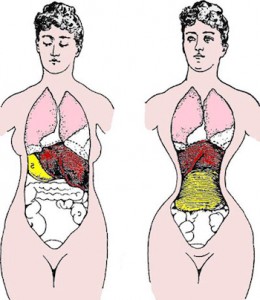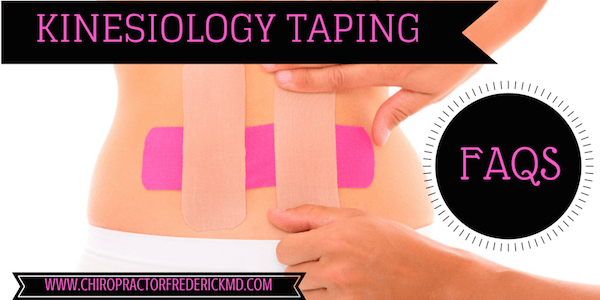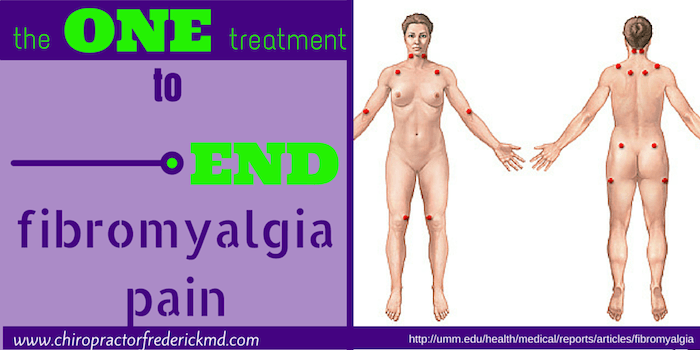“Waist Training” emerges and Frederick MD chiropractor finally loses sanity
Frederick chiropractor encounters “waist training,” exclaims: “I feel like I’m taking crazy pills!”
I think this is it… I may have finally lost my sanity. The other evening (while trying to go to bed), I saw an Instagram post (from one of my Insta-friends) showcasing “waist training.” Is she wearing a corset? I blinked, rubbed my eyes, and turned up the brightness on my phone. It sure did look like a corset. It can’t be. What “training” could you possibly do in a corset? Maybe this is a joke. Maybe I’m seeing things. I looked at her Insta-comments: things like “looking great girl!” “keep up the good work!” “it’ll all be worth it soon!” and “I’m going to have to try this!” littered the comment section. Keep up what good work? Try what? What in the world is “waist training?”
Well, I guess I won’t be going to sleep anytime soon. See, I have this inability to complete/continue a task if I encounter something I don’t know. If I don’t know what a word means, I will look it up immediately (thank you, urban dictionary ;) ). If I hear about a new trend or medical treatment, I must find out about it NOW. My curiosity of “waist training” and need for instant information didn’t serve well for my sleep that night. The information I gathered on waist training didn’t serve well for my sleep the subsequent nights, OR my sanity. I still am in disbelief that people are doing this…
So what is waist training?
Waist training, also known as “tight-lacing,” “getting waisted” waist erasing” and “corset training,” is a process where people try to shrink their waist sizes by wearing tight, compressive corsets. The goal in waist training is to wear the corset for as many hours in a day as possible, with the hopes of permanently or semi-permanently reducing the waist size. Some people report wearing the corset for 23 hours a day. While doing a waist training protocol, individuals may focus on reducing calories consumed, limiting “unclean” foods (junk foods), and exercising in the corset, but the most common aspect is the corset cinching/tightening.
Why are so many women waist training?
Does having a smaller waist give you some sort of advantage in sport? No.
Does it help increase longevity or prevent some sort of scary disease? No.
Does it improve your overall health? No.
Does it improve self-image? Debatable. I feel like it reinforces image as the main component of self-worth, which is superficial and vain. But that is just my opinion.
Is it a fast way to achieve abnormal and exaggerated body modifications to reinforce societies unrealistic expectations of what women should look like? Ding! Ding! Ding! Ding!
The reason so many women are waist training is simple. Vanity. And hopefully ignorance. My goal is to educate all of you beautiful women (and men!) on the short and long-term consequences of “corset training,” so that you reconsider putting your bodies through this unnecessary mutilation.
Modification or mutilation?


On first thought, I assumed everyone MUST know how dangerous it is to tightly compress all of the most important organs in your body. Oh how wrong I was. The more I researched waist training, the more I found people ecstatically doing it. There is large a cult-like following of waist-trainers with impending (or existing) eating disorders and body image issues. I mean, if Jessica Alba and Kim Kardashian are doing it, it must be safe right? Some of the waist training websites even talk about all of the health benefits of waist training– from constipation relief to headache reduction and everything in between. WHAT??? I CANNOT EMPHASIZE ENOUGH HOW WRONG THEY ARE AND HOW DANGEROUS THIS IS!!!
I urge you to continue reading and to discover the short and long-term complications of using a corset before deciding to use one.
Short-term complications

Indigestion
The compression of the corset causes compression and increased pressure within the stomach. The stomach isn’t capable of handling as much food (similar to a lap band), and the pressure causes upward movement of stomach acids. The pain associated with indigestion is called heart burn.
Heartburn
Heartburn is a symptom of indigestion (see above) that feels like tightness, burning, pain, or discomfort in the chest that is due to the stomach acid eroding the tissues of the esophagus.

Decrease in Lung Capacity
The ribcage is supposed to move freely to allow for expansion of the lungs. The corset inhibits the full expansion of the ribcage, and doesn’t allow the lungs to fully inflate. When this happens, only the upper part of the ribcage can expand, and causes an over-working of the accessory muscles of respiration. This will eventually lead to upper back and neck pain, because those muscles aren’t supposed to work that much.
Shortness of Breath
Because the lungs can’t fully inflate, a corset wearer may have difficulties achieving adequate respiration and will experience shortness of breath.
Increase in Peritoneal Pressure
The corset takes a very tightly-packed abdomen, and then squeezes it even more. The organs are squished and displaced, reducing the blood flow and function of the organs.
Faintness
Tight corsets may impede the venous return of blood from the lower part of body. If there is excess blood in the lower half of the body, and blood flow and oxygen are reduced to the brain, the end result is fainting.

Chafing
Because the corset is so tight against the skin, the pressure and compression may irritate the skin causing chafing, bruising, and callous formation.
Bloating
Increasing the pressure on the intestines and bowels make it harder for them to work. Bowel movements/ intestinal transit may slow with the use of corsets, so stool and waste may take longer to evacuate. Having excess stool build up in one’s intestines will definitely make a person feel bloated.
Long-term complications
Visceroptosis
All of the organs are held in certain places in the thoracic cavity and abdomen by connective tissues. When these organs are squeezed and pushed in different directions for long periods of time (thank you, corsets), it can weaken and lengthen the connective tissue. Visceroptosis is a condition where the organs have weakened connectors, and are “sagging” in a downward fashion. Side effects of visceroptosis are: heart burn, constipation, diarrhea, abdominal distension, vertigo, loss of sleep, and headache (just to name a few common ones).
Chlorosis
Is an anemic condition that is marked by pale skin, fainting, tiredness, and breathlessness. This is a term that was used in the past when using corsets was commonplace, though isn’t used much nowadays.

Malnutrition
As the stomach is displaced and squished, eating habits have to change. Eating large portions becomes impossible and eating food may become uncomfortable. With the reduction in portion size and eating frequency, one runs the risk of reduced food intake and malnutrition.
Difficulty Conceiving
When the menstrual cycle in a woman is disrupted (see amenorrhea above), this causes complications with conception and may make it impossible for a woman to get pregnant.
Amenorrhea
When women experience malnutrition (see above) and reductions in body fat percentage, amenorrhea (when a woman’s period goes away) may occur.
Compression of Obstetrical Pelvis
Wearing a corset long term has been shown to decrease the size of the obstetrical pelvic inlet, which can be detrimental to the developing fetus and could cause complications during the birthing process.

Hiatal Hernia
The pressure of the corset increases the abdominal and thoracic pressure and forces the stomach upward. Sometimes the pressure is so great that the stomach is pushed through the hole (hiatus) in the diaphragm where it does not belong. Over time, this can cause bleeding, ulcers, esophageal stricture (esophagus gets narrow due to scar tissue and needs to be expanded with a special tool or surgery), and cancer due to changes in the esophageal tissue.
Difficulty Swallowing
Scar tissue will build in the esophagus from the damage created by the acid reflux. The scar tissue makes swallowing food and drink difficult.
Premature Degeneration of Spine
The entire back is meant to move- that is why we have so many individual vertebrae and joints back there! Each joint is responsible for a certain degree of motion when we move, and the movement helps lubricate the joints in the spine. Making a section of the spine immobile (ie. when wearing a corset) negatively changes the biomechanics of the spine. When you go to move, some joints are not moving enough (low and mid back), which means other joints have to move more (upper back). When joints are exposed to extra movement stress, they are predisposed to undergo premature degeneration. Similarly, when joints don’t move enough, they don’t receive adequate lubrication and nutrients, and will also degenerate faster.
Chronic Back Pain
Wearing a corset can predispose the spine to premature degeneration (see above example), which can be a painful process. Degeneration of the spine cannot be reversed, and thus can be a contributor of chronic back pain.
Dependence on Corset for Support
While wearing a corset, one may feel “supported” and may have the sensation of improved posture. This is because the corset is like a stronger version of your core muscles. While wearing a corset, your abdominal muscles and core do not need to work- the corset is doing more than enough “supporting.” Over time, the core muscles atrophy (shrink and get weak) since they are not being challenged. Upon removal of the corset, the core muscles are weak, and the body will feel unsupported. Without proper rehabilitation from a corset, a person will likely revert back to corset wearing to receive the support that their own core is no longer able to provide.
Inhibition of Diaphragm
Inhibition of diaphragm The diaphragm is a critical part of respiration, and is responsible for allowing for maximal inflation of the lungs. The diaphragm contracts and pushes abdominal contents downward, allowing the lungs to fully expand. Wearing a corset does not allow the diaphragm to do its job, so it just sits there and gets weak while the corset does its damage. Over time, the body develops a compensatory breathing pattern that excludes the diaphragm (this is bad!), and relies solely on the accessory muscles of respiration and the upper intercostal muscles. This is considered a dysfunctional breathing pattern and may cause many health problems in the future including constipation, neck pain, and head aches.
And if that wasn’t enough to scare you…
How about some problems “down there?”
Wearing a corset increases the pressure on the pelvic floor, reproductive organs, and organs responsible for waste removal. As seen in the “visceroptosis” complication, sustained pressures and displacement of organs can cause a weakening of the connective tissues that hold them in place. In the pelvis, the following can occur due to unnatural pressures on the pelvic floor:
Warning: The Content and Pictures Below Are Real and Graphic –
View at Your Own Risk!
Bladder Prolapse

Rectal Prolapse

Uterine Prolapse

Small Bowel Prolapse

Hemorrhoids

Urinary Incontinence
When the connective tissues of the bladder are stretched and put under sustained pressure (like during pregnancy and while corset wearing), they become weakened and less capable of maintaining normal function. The urethral ligaments that help “kink” the ureter become stretched, and are no longer able to sufficiently stop the flow of urine. The result is urinary incontinence, which is exacerbated by stress to the area (coughing, running, laughing).
Painful Sex and Decreased Sex Drive
The increase in pressure on the pelvic floor causes unnecessary strain on the muscles and may completely change the structure of the pelvic floor (see above examples of prolapse). Many of the above listed conditions, and abnormal stresses on the pelvic floor muscles can cause painful intercourse. Pain during intercourse is not fun, and therefore women are less likely to want to have sex.
When you consider all of the negative side-effects and complications that can accompany waist training, it seems inconceivable that a person would still consider putting her (or his) body through such abuse and mutilation all for the sake of appearance. There will be a few die-hard “corseters” who choose to ignore my warnings, and I will end this educational rant with this message to them:
Dearest die-hard “Waist Trainers,”
My office is at 604 Solarex ct #101 Frederick, MD 21703. I look forward to seeing you on a regular basis in the future. I hope your damage, dysfunction, and pain isn’t permanent. There is a good chance I won’t be able to fix everything, but I will try my best to rehabilitate and restore what I can. It is going to take a lot of work on both of our ends, with no guarantees, so I hope you’re up for the challenge.




















Misty Cosman March 3, 2015
Great blog. I never knew so many people did this. I thought it was done more “back in the old times”. Very informative.
RepliesDr. Cassie Dougherty March 4, 2015
Thanks Misty! Unfortunately I think corset wearing/training is becoming more widely accepted as the public watches celebrities do it. I hope it eventually becomes a thing of the past again!
RepliesLaurie Logan March 3, 2015
Frightening what women do for “beauty’s” sake! Hopefully, this is a fad that wanes soon.
RepliesExcellent post!
Dr. Cassie Dougherty March 4, 2015
Thanks Laurie! I agree. I will be jumping for joy when this trend wears off. Then it will be time to tackle to stiletto shoe crisis! I don’t think people realize how damaging these things can be long term. I battle the long-term consequences of these beauty trends everyday in my office- it’s scary!
RepliesMarike Smit March 22, 2015
This is a brilliant and informative post. I think anyone who isn’t deterred by the photographic evidence has a serious psychological problem.
RepliesDr. Cassie Dougherty March 23, 2015
Thank you so much Marike, I really appreciate it :) I can’t imagine putting my body through that type of abuse.
Repliescassie August 7, 2015
What about the people who have a medical problem & use a corset to help support them?
RepliesIm not talking about tight lacing. People who suffer Ehlers Danlos or benign joint hypermobility find a combination of core muscle exercise, weight training and corsets improve quality of life as it decreases subluxation.
I cycle, walk, do yoga, pilates and dance and yet still have issues with joints popping out of alignment, my pelvis can be thrown out by walking around a corner or a directional change while walking, this causes sciatica. I wear a corset for approximately six hours a day (when not exercising) never for sleeping in. It has reversed chronic upper back pain, stabilized joint hypermobilty in my pelvic region and sacrum. I have not had a panic attack since wearing a corset or incidentally an asthma attack. My natural waist is 27inches and when done up the corset changes this only by one to two inches. I use a tape to check I am not over compressing. I agree that people who over tighten and abuse corsets are doing them self serious damage – you didn’t even mention the kidneys and adrenal glands. However, used in conjuction with an exercise program and healthy lifestyle choices for some people they can improve quality of life. I have no desire to rearrange my internal organs, but I wish to remain pain free without having to take pain killers. long term pain management using paracetamol is dangerous, it causes internal bleeding (New Scientist) and serious iron deficiencies.
Dr. Cassie Dougherty October 20, 2015
Thank you for your comment. I have no issue with using back braces under the guidance of a medical professional. In fact, I even prescribe braces for some of my patients when it is appropriate. I am glad that you have found relief with using a corset, and am even happier that you’re not using it for cosmetic reasons or to see how little you can make your waist. Thank you again for your input and for sharing your experience of corseting with me :)
Repliesanonymous August 30, 2015
Thanks a lot for this post. I’m a young french women and i was considering to start a waist training. By making some research i found your blog. As we can read and heard so many good things about corset on social medias, i didn’t expected that it was wrong. Even heard some physician said that it causes no harm at all.
RepliesDr. Cassie Dougherty October 20, 2015
Thank you for your comment and for seeking more information on waist training. I am glad you found my post helpful :)
RepliesBri October 20, 2015
I am absolutely appalled that you would STEAL photos in order to post pseudo-science and fear mongering.
You should remove the licensed photos from your cover picture, because there are some extremely talented makers who are not going to take that abuse lightly.
PS – those prolapse pictures, while horrifying, are most usually caused by pregnancy and birth, and congenital weakness of the pelvic floor.
RepliesDr. Cassie Dougherty October 20, 2015
No pseudoscience here. I have removed the pictures, and I appreciate your feedback. My position on waist training remains the same. There may be many conditions that are more likely to cause prolapse than waist training, but that doesn’t mean that pelvic organ prolapse isn’t possible while waist training.
RepliesTracyK May 9, 2017
Yes, as a chiropractor, I find this completely hyperbolic. Where are the sources here?
Corsets and waist trainers are two different items, for one. Also, saying that the person is going to suddenly starve and suffer from malnutrition is a quite a reach.
The main risk is going to muscle atrophy, just like with any brace.
RepliesCatherine October 20, 2015
Have you ever worn a corset yourself?
RepliesHave you tried any kind of body “modification” or as you also called it “mutilation”?
Have you asked the permission of the women in the pictures in you have in this post?
Dr. Cassie Dougherty October 20, 2015
I HAVE worn a corset, but only for a very short period of time.
RepliesI HAVE modified/mutilated my body, if you consider piercings and tattoos as such. That’s about the extent of it though.
I did not ask permission, and therefore took the pictures down. They were meant to be educational. I did not realize it would offend so many waist trainers. My apologies.
Alexandria Web October 20, 2015
You know your sources are way out of date right? And that a lot of what your talk about in this article isn’t covered in your sources? And that you just lifted a bunch of photos without context or sources? And that the diagram of the squished organs isn’t even vaguely realistic because the uncorseted drawing was obviously done by someone who had a very poor grasp of anatomy? So professional.
RepliesCorsets causing infertility and spontaneous deaths obviously explain why the human race was wiped out over 100 years ago, or you know not.
Susan October 20, 2015
How inconsiderate of you to use a person’s pictures, at the very top, with out their permission.
Two, you failed to.mention how Pregnancy actually moves organs around much more than a corset ever could.
Three, the only image you posted of “What the organs look like in a corset” is from an old medical journal from the 1800’s. The Doctors (or one of the shows like it) did a special where they put a professional waist trainer in an MRI safe corset that proved the organs shifted safely beneath her skin and the corset. You should Google those images.
Four, Corsets are used for many medical reasons, not just to modify the way a woman’s waist looks. Some people actually use them, under the guide of a doctor, to help with aligning and supporting their damaged or injured spines, much the way a brace would. Some women also use some types of corsets with much less curve to them as compression therapy to help with anxiety.
Five, Those things the Kardashians and other famous people use are rubber Fajas with some metal pieces in them. Those are NOT corsets.
I do not waist train regularly, by any means, nor am I a professional or an expert on them. Anyone that actually wants to know about corsets should do REAL research that shows them the negatives and the positives of wearing a corset, not just the blatant fear mongering that your article does. This blatant misinformation that shows all of these shocking images can also be caused by having children, or old age in general. Those external hemorrhoids? Those can be caused by straining too much to poop. The prolapsed bladders? Do you know how common it is to have to have surgery to tack your bladder up as your age progresses, or as you have children?
Your article is NOTHING but blatant fear mongering. It just has the feature of sounding educated. And maybe it is to a point. But you are a chiropractor, not a medical doctor.
RepliesDr. Cassie Dougherty October 20, 2015
1. My apologies for using another person’s images. I have removed them from the post. My intention wasn’t to hurt their feelings, but to merely educate people about what waist training looks like.
2. This was not a post about pregnancy. I’m sure I could think of many circumstances which alter the arrangement of the internal organs, but that was not my focus for the blog post.
3. I will gladly google the images. The illustration was meant to serve as a representation of what can happen with the organs. It is obviously not anatomically precise image, as it is an illustration.
4. I am well aware that people are prescribed medical bracing and that it can be beneficial to certain conditions. In fact, in appropriate situations, I will even prescribe bracing (though I don’t very often). Medical bracing and corseting for cosmetic reasons (while NOT under the care of a medical professional) are two COMPLETELY different things.
There are many scenarios that can cause the prolapsing of organs and hemorrhoids. This article focused on waist training as a potential cause of them. Do 100% of the people who corset have prolapse issues? Certainly not. Can having a large bowel movement or lifting lots of weights in the gym cause hemorrhoids or prolapse in the right scenario? Sure. Is corseting potentially dangerous? Yes. Is corseting without the guidance of a medical professional a choice? Yes. It was my intention in posting this article to make people think twice before corseting while presenting peer-reviewed research.
Though I am “just” a chiropractor, I have yet to meet with a medical doctor, or any other medical professional who disagrees with my position on corseting.
As always, I appreciate your feedback and comments.
RepliesClaudia April 13, 2017
Thank you so so so so much❤️
RepliesClaudia April 13, 2017
Thank you so so so so much❤️
RepliesTonny June 29, 2017
How do you pick the right waist trainer ?
RepliesLyla March 23, 2019
Measure the smallest part of your waist and measure your torso from under your breats to your hip bone. That will tell you the size you need and I reccomend luxx curves waist trainers they’re great quality. The thing about this post is that this guy is talking about corsets not waist trainers. Waist training is a slow lengthy process and it doesn’t hurt. It helps your posture and eating habits and it slowly gives you an hour glass shape. When you stop wearing it for awhile that goes away so I don’t see how it could affect pregnancy. If you’re trying for a baby you shouldn’t be wearing a waist trainer anyway lol that’s just ignorant. Anyway check out luxx curves and they can help you find the right size and type of trainer. Also they have a YouTube channel and it’s very informative I watched everything before I bought one. There are many benefits of using waist trainers and i absolutely love mine.
RepliesSHOP4FUN June 3, 2018
I believed waist training is not dangerous if you wearing properly. Otherwise, waist trainer corset will hurt you.
RepliesJolise June 3, 2018
Do waist cincher really work ? I’m planning to start my waist training journey and hope you can give me some advise.
RepliesJeff Tan June 4, 2018
Pick a best waist trainer is very important.
RepliesMarian Howard June 25, 2018
Your competition is not other people but the time you kill, the ill will you create, the knowledge you neglect to learn, the connections you fail to build, the health you sacrifice along the path, your inability to generate ideas, the people around you who don’t support and love your efforts, and whatever god you curse for your bad luck. Have you information: https://waistlab.com/best-waist-shaper/
RepliesRuben November 5, 2020
Hi, This is a nice article you shared great information. I have read it Best waist trainer thanks for giving such a wonderful blog for the reader.
RepliesFelix Meyer June 28, 2024
Hey there, I love all the points you made on that topic. There is definitely a great deal to know about this subject, and with that said, feel free to visit my blog Webemail24 to learn more about Gold and Silver.
Replies